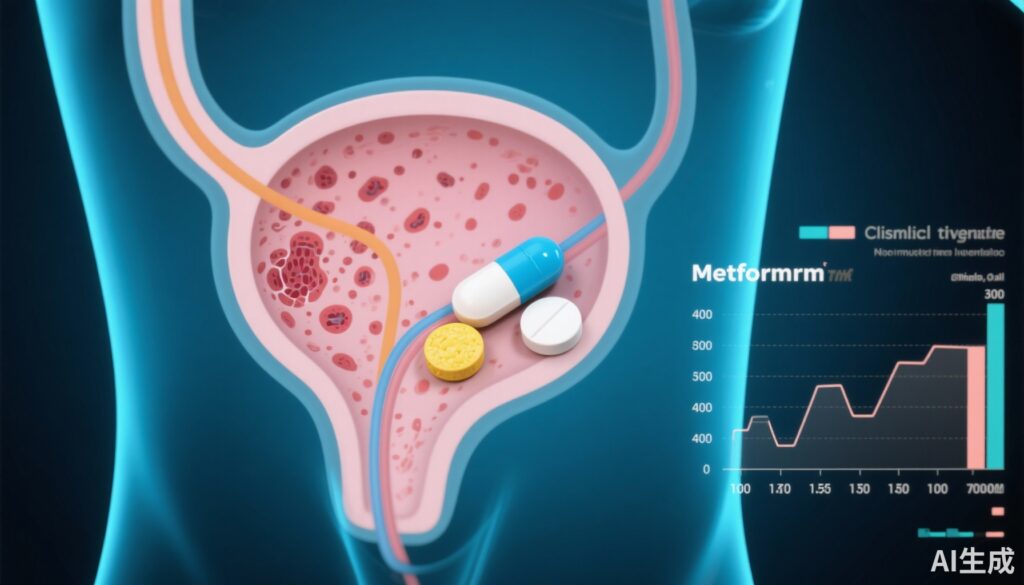Highlight
– Oral metformin treatment in patients with low-grade non-muscle-invasive bladder cancer showed limited antitumor efficacy, with only one complete and one partial response among 11 patients.
– Metformin was well-tolerated, with mild diarrhea being the most common adverse event.
– Urinary metformin concentrations exceeded systemic blood levels, but no significant changes were observed in immunohistochemical markers linked to metformin’s proposed mechanisms of action.
– The study concludes that oral metformin lacks conclusive evidence for antitumor benefit in NMIBC marker lesions.
Study Background and Disease Burden
Non-muscle-invasive bladder cancer (NMIBC) accounts for approximately 70–80% of newly diagnosed bladder cancer cases, characterized by tumors confined to the bladder’s mucosa or submucosa (Ta, T1 stages). Despite generally favorable prognoses compared to muscle-invasive bladder cancer, NMIBC’s clinical management is challenged by high recurrence rates and the necessity for repeated intravesical therapies and surveillance cystoscopies, impacting quality of life and healthcare resources. Conventional intravesical treatments include Bacillus Calmette-Guérin (BCG) and chemotherapy agents, but treatment failure rates and side effects underline the urgent need for alternative, safe, and effective therapies.
Metformin, a widely prescribed antidiabetic agent, has garnered interest for its potential anticancer properties due to mechanisms such as AMP-activated protein kinase (AMPK) activation, inhibition of mTOR signaling, and effects on tumor metabolism. Observational studies have suggested decreased cancer incidence and mortality among diabetic patients treated with metformin. While some preclinical bladder cancer models demonstrated metformin’s inhibitory effects on tumor growth, there has been a lack of clinical data evaluating its activity specifically in NMIBC.
Study Design
This open-label, multicenter, phase II marker lesion trial enrolled 11 patients diagnosed with primary or recurrent, multiple, low-grade Ta-T1 NMIBC. After initial transurethral resection of bladder tumor (TURBT) to confirm histology, a single tumor was deliberately left intact to serve as a marker lesion to evaluate treatment response.
Participants received oral metformin escalated up to 3000 mg daily for three months as the intervention. Key endpoints included the response of the marker lesion (complete response, partial response, or no response), safety assessments, patient-reported quality of life, pharmacological measures of metformin concentrations in urine and blood, and immunohistochemical evaluation of tumor tissue before and after treatment to explore changes in markers associated with metformin’s proposed mechanisms (e.g., AMPK activation, mTOR pathway).
No comparator arm or placebo control was included, given the early-phase exploratory nature focusing on signal detection in marker lesion size and biology.
Key Findings
Among the 11 patients treated with oral metformin, the following outcomes were observed:
– Tumor Response: A complete response (disappearance of the marker lesion) was noted in one patient, and a partial response (approximately 50% reduction in lesion size) was seen in another. The remaining nine patients experienced no significant change in the marker lesion’s size.
– New Lesion Development: Five of the nine non-responders developed new low-grade Ta lesions during or after treatment, indicative of ongoing disease activity despite therapy.
– Safety Profile: Metformin was generally well tolerated. The most frequent adverse event was grade ≤ 2 diarrhea, affecting nine patients, with no serious treatment-related adverse events reported.
– Pharmacokinetics: Metformin concentrations measured in the urine were significantly higher than systemic blood levels, consistent with renal elimination and possible drug exposure within the bladder environment.
– Immunohistochemical Analysis: Tissue evaluations before and after metformin treatment did not reveal any statistically significant changes in expression of markers related to metformin’s putative tumor suppression mechanisms, such as AMPK activation or mTOR pathway inhibition.
The limited tumor responses, combined with the absence of mechanistic modulation and the emergence of new lesions, do not support a robust antitumor effect of oral metformin in NMIBC.
Expert Commentary
This investigation is significant as one of the first clinical trials directly assessing oral metformin’s activity in marker lesions of NMIBC. The marker lesion design allows for a nuanced observation of tumor biology during treatment without immediate complete resection, which is informative but carries limitations.
The small sample size (n=11) and lack of a randomized control group limit definitive conclusions regarding efficacy. The choice of oral administration, despite metformin’s known rapid renal clearance and higher urinary concentrations, raises questions whether systemic dosing translates into sufficient intravesical drug concentration for tumor cytotoxicity or cytostasis.
Furthermore, the immunohistochemical findings suggest a lack of direct biological effect on key signaling pathways implicated in metformin’s hypothesized anticancer activity. This may indicate that metformin’s mechanisms may not be operative in bladder epithelial tumor cells or require longer treatment duration or higher localized drug delivery.
Current NMIBC treatment guidelines emphasize intravesical therapies for recurrence reduction, where direct bladder exposure is critical. Oral metformin might not achieve the therapeutic concentration needed intravesically, contrasting with BCG or intravesical chemotherapeutics.
Despite these limitations, this study contributes valuable clinical data to an active research area investigating repurposing of metformin in oncology. It underscores the necessity for alternative approaches, including intravesical administration routes, combination therapies, or patient stratification based on tumor biology to clarify metformin’s role.
Conclusion
The phase II marker lesion study assessing oral metformin in patients with low-grade NMIBC provided limited evidence for its antitumor activity, with only one complete and one partial tumor response noted among 11 patients. Though generally well tolerated, metformin treatment did not induce measurable changes in tumor biology markers, and several patients developed new low-grade lesions during therapy.
Consequently, oral metformin cannot be currently recommended as an antitumor agent for NMIBC based on available evidence. Future research should focus on optimizing drug delivery, understanding tumor-specific responses, and exploring synergistic treatment combinations. This study highlights the challenges in translating preclinical anticancer properties of metformin into clinical efficacy for bladder cancer.
References
van Hattum JW, Remmelink MJ, Nuijens ST, de Ruiter BM, Hooijer GKJ, Oddens JR, Savci-Heijink CD, Mathot R, Witjes JA, Pollak MN, de Reijke TM, Molenaar RJ, Wilmink HW. A study of oral metformin for the intravesical treatment of non-muscle-invasive bladder cancer. BJU Int. 2025 Oct;136(4):738-746. doi: 10.1111/bju.16767. Epub 2025 May 22. PMID: 40404168; PMCID: PMC12415309.
van der Heijden AG, Witjes JA. Bladder cancer: novel treatment approaches for non-muscle-invasive bladder cancer. Nat Rev Urol. 2018;15(7):425-426. doi:10.1038/s41585-018-0033-5
Jiang T, et al. Metformin in lung cancer: a systematic review and meta-analysis. Cancer Manag Res. 2020;12:10287-10300. doi:10.2147/CMAR.S274453
Zanella C, et al. Metformin and cancer: New uses for an old drug. Sci Transl Med. 2023;15(677):eabe6751.
Madeo F, et al. Metformin and anti-aging: an open challenge. Cell Metab. 2024;36(6):1036-1048. doi:10.1016/j.cmet.2024.05.004



